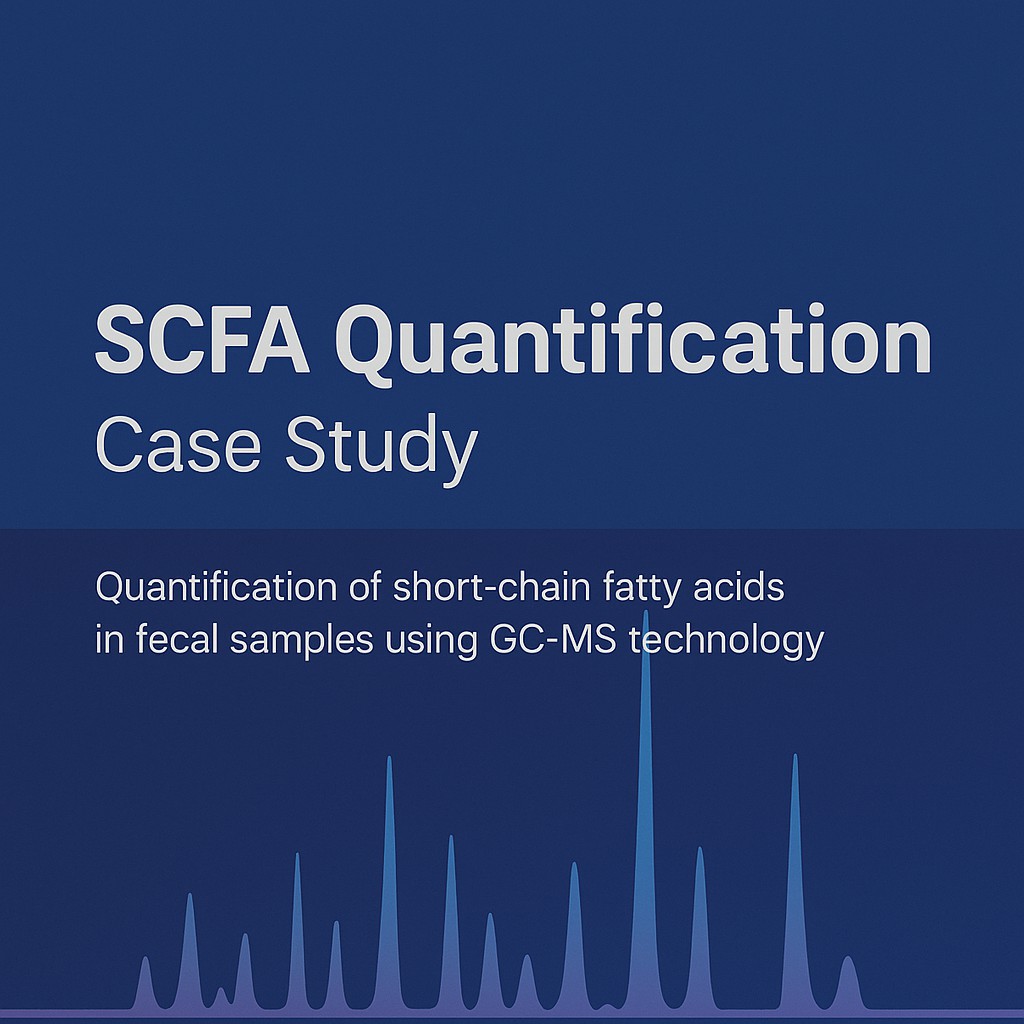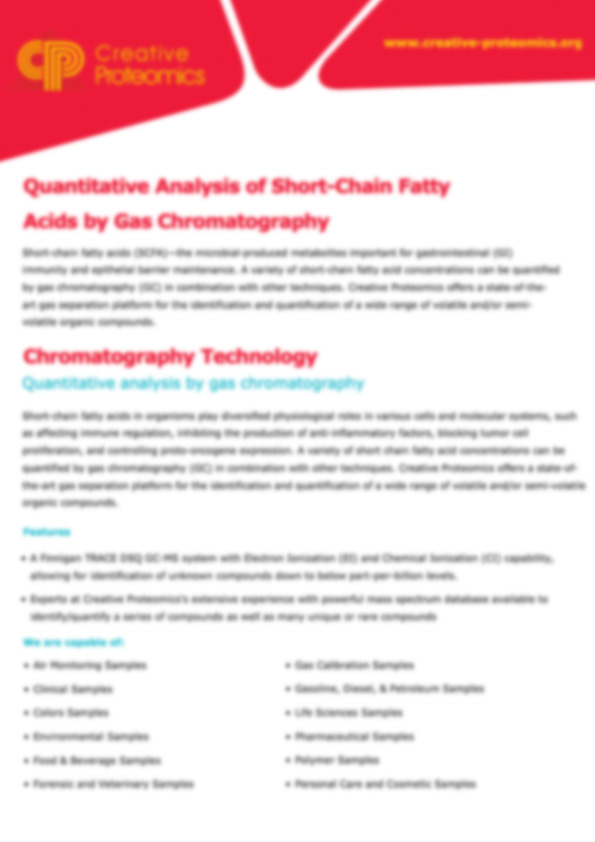Fatty Acid Metabolism Analysis Service for Accurate Lipidomics Research Results
Creative Proteomics provides comprehensive fatty acid metabolism analysis services, leveraging state-of-the-art GC-MS and LC-MS/MS technologies to deliver highly accurate profiling and quantification of over 40 fatty acid species. Our advanced isotope-labeled workflows ensure precise measurement, even for low-abundance metabolites, supporting robust, reproducible results.
Whether your research focuses on lipid metabolism in diseases, biomarker discovery, nutritional studies, or pathway analysis, our service offers tailored solutions for insightful data interpretation and reliable publication-ready results.
Get Your Fatty Acid Analysis Plan
×- What is Fatty Acid Metabolomics
- Analyte Coverage
- FAQ
- Demo
- Publication
Why Fatty Acid Metabolomics Matters
Fatty acids are not merely energy stores—they're crucial regulators of cell signaling, membrane integrity, and disease pathways. Precise fatty acid metabolomics reveals shifts in metabolic states, offering insights into:
- Disease mechanisms in diabetes, cancer, cardiovascular disorders, and neurodegeneration
- Biomarker discovery for diagnostics and therapeutic development
- Nutritional interventions and diet-related health impacts
- Pharmaceutical research and drug safety evaluations
Creative Proteomics offers a robust platform for fatty acid metabolomics, ensuring high precision, reproducibility, and flexibility across diverse research fields.
What is Fatty Acid Metabolomics
Fatty acid metabolomics involves comprehensive profiling and quantification of fatty acids and their derivatives in biological systems. These analyses capture dynamic changes in lipid composition that reflect metabolic health, disease mechanisms, and therapeutic interventions. Through advanced GC-MS and LC-MS/MS platforms, fatty acid metabolomics enables:
- Identification of disease-related metabolic shifts
- Discovery of lipid-based biomarkers
- Evaluation of drug and nutritional impacts
- Understanding of lipid regulatory networks and metabolic flux
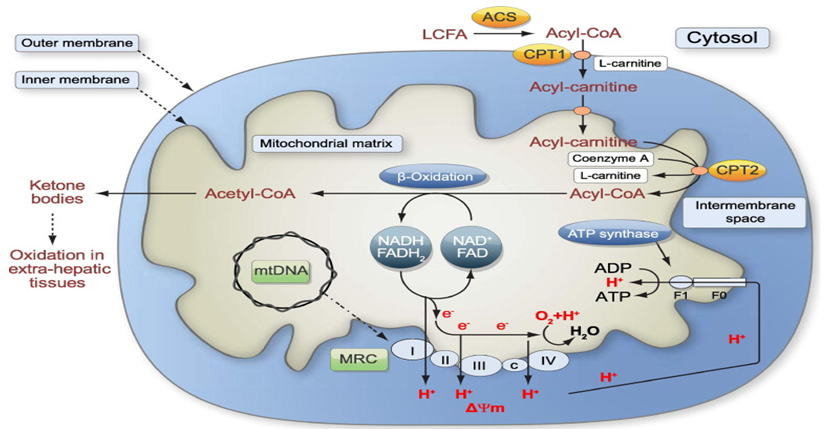
Types of Fatty Acids: Why Classification Matters
Fatty acids differ in structure and function. Accurate classification and measurement are essential for interpreting lipid metabolism and linking specific fatty acids to health or disease states.
Chain Length
- SCFAs (<6 carbons): Gut-derived metabolites critical for immune function and gut health.
- MCFAs (6–12 carbons): Rapidly metabolized energy sources important in metabolic and nutritional studies.
- LCFAs (>12 carbons): Major components of membranes, critical for signaling and energy storage.
Degree of Saturation
- SFAs: Key for energy storage; associated with cardiovascular health concerns.
- MUFAs: Linked to beneficial effects on lipid profiles and metabolic health.
- PUFAs: Play significant roles in inflammation regulation and disease modulation.
Double Bond Configuration
- Cis-fatty acids: Maintain membrane fluidity and biological functions.
- Trans-fatty acids: Often linked to negative health outcomes, significant in dietary research.
Profiling these variations is vital for lipidomics research, disease risk assessment, and therapeutic development.
The Four Core Roles of Fatty Acids in Biology
Fatty acids perform diverse and essential biological functions:
- Membrane Structure and Integrity
Integral components of phospholipids and glycolipids, influencing cell membrane fluidity, signaling, and permeability. - Protein Targeting and Function
Many fatty acids act as lipid anchors, guiding proteins to membranes where they execute vital cellular roles. - Energy Metabolism
Stored as triacylglycerols, fatty acids serve as key energy reserves. β-oxidation converts fatty acids into acetyl-CoA, fueling ATP production. Disturbances in these pathways relate to metabolic disorders like diabetes or fatty liver disease. - Cellular Signaling and Regulation
Fatty acid derivatives—including prostaglandins, leukotrienes, and endocannabinoids—serve as potent signaling molecules, regulating inflammation, immunity, and cell proliferation.
Comprehensive profiling of these functions through fatty acid metabolomics yields insights essential for biomedical research and therapeutic innovation.
Analytical Techniques for Fatty Acid Profiling
Creative Proteomics leverages a range of analytical methods to ensure precise, comprehensive fatty acid analysis. The table below compares key techniques:
| Technique | Strengths | Limitations | Applications |
|---|---|---|---|
| GC-MS | - High resolution and separation efficiency - Excellent for SCFAs and volatile compounds - Isotope-labeled standards enable precise quantification | - Requires derivatization for some fatty acids - Less suitable for thermally labile compounds | - SCFA profiling - Total fatty acid composition - Trans/cis isomer differentiation |
| LC-MS/MS | - Exceptional sensitivity - Detects complex lipid mediators - No derivatization required | - Higher matrix effects in complex samples - Less effective for highly volatile analytes | - Eicosanoids, endocannabinoids, HETEs - Targeted lipidomics - Biomarker discovery |
| TLC | - Simple and inexpensive - Quick screening | - Low sensitivity - Limited quantification capability | - Preliminary lipid class separation |
| HPLC | - Good for non-volatile fatty acids - Flexible solvent systems | - Lower sensitivity vs. MS techniques | - Separation of lipid classes - Preparative work |
| FTIR | - Rapid analysis - Minimal sample prep | - Limited specificity - Cannot quantify individual fatty acids | - Functional group analysis - Bulk lipid characterization |
| NMR | - Structural elucidation - Non-destructive | - Lower sensitivity - Requires large sample amounts | - Structural confirmation - Quantification of total lipid fractions |
How Our Fatty Acid Metabolism Analysis Works
Fatty acid metabolism consists of two key processes:
- β-Oxidation
Sequentially breaks down fatty acids into acetyl-CoA units, producing ATP and revealing metabolic flux changes in health and disease. - Fatty Acid Synthesis
Builds fatty acid chains from acetyl-CoA through elongation cycles. Dysregulation of this pathway can contribute to inflammation, cancer progression, and metabolic disorders.
Our analysis integrates measurements of intermediates and end products from both pathways, providing comprehensive metabolic insights relevant to disease research, drug development, and nutritional studies.
Workflow

Bioinfomatics Service
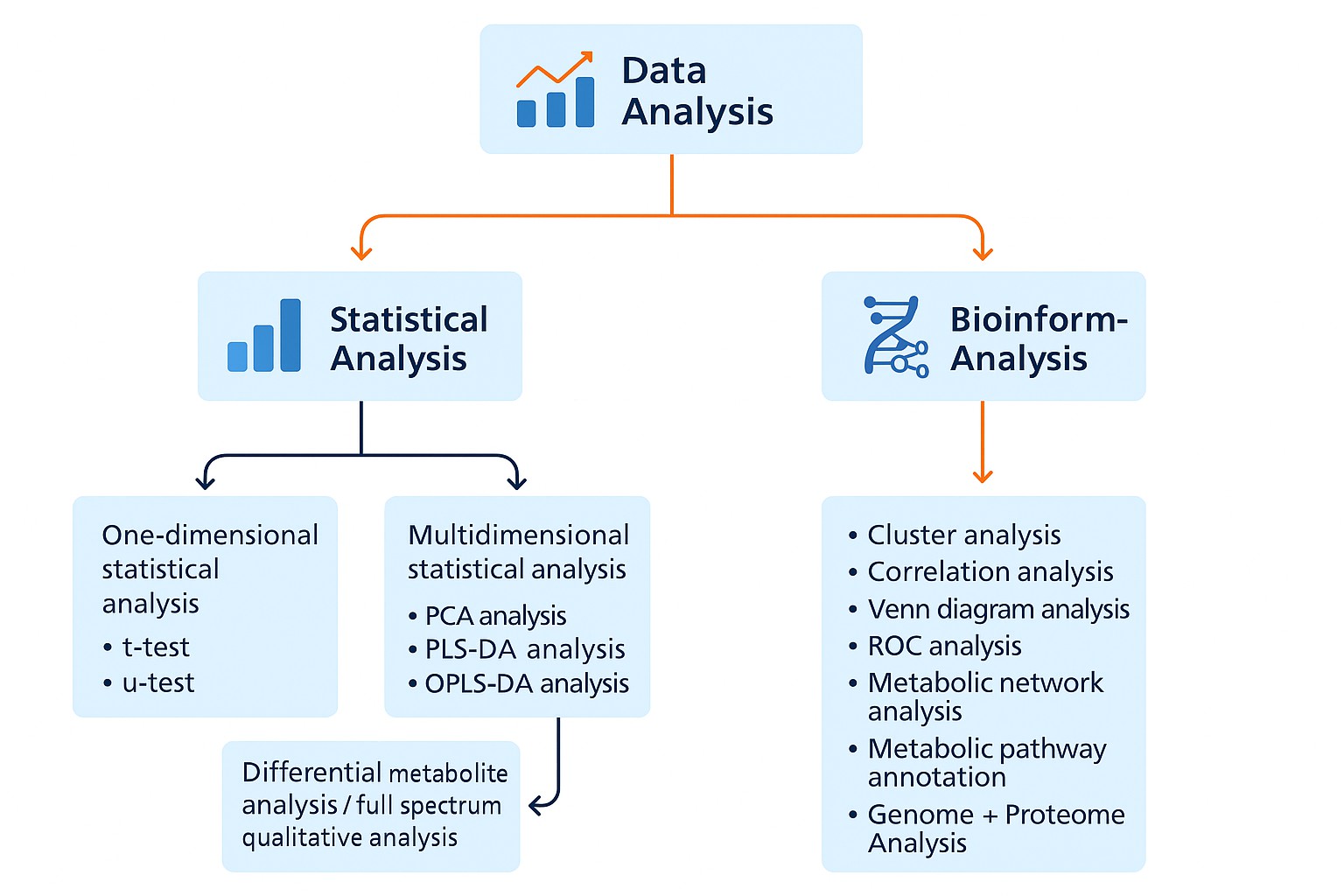
Our LC-MS/MS and GC-MS Platforms for Fatty Acid Metabolite Profiling
Creative Proteomics offers unparalleled fatty acid metabolite profiling using:
LC-MS/MS
- Quantifies lipid mediators like prostaglandins, leukotrienes, and CYP450 products with high sensitivity.
- Delivers reproducibility with CVs<10%, suitable for biomarker discovery and therapeutic studies.
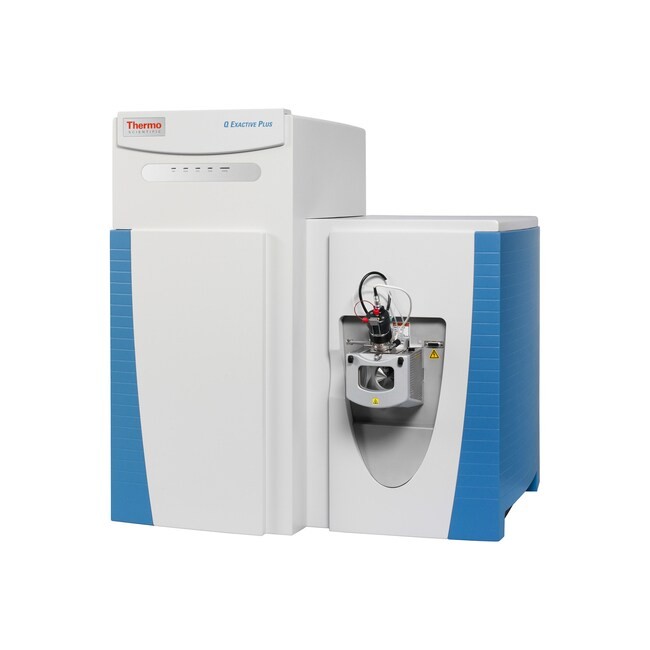
GC-MS
- Precisely profiles free and esterified fatty acids, including SCFAs, omega-3/6, and trans fatty acids.
- Leverages isotope-labeled internal standards for reliable quantification and clear chromatographic separation.
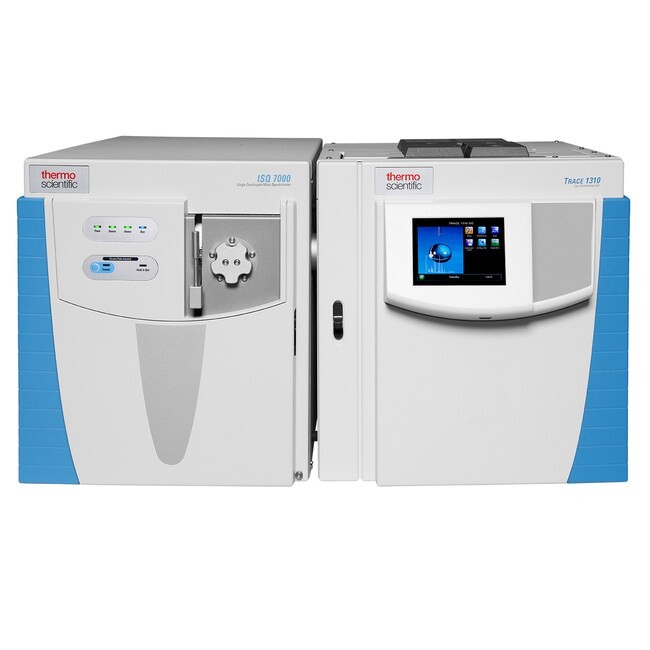
Our integrated platforms empower clients with high-resolution lipidomics data essential for advancing biomedical research, nutrition science, and pharmaceutical development.
Analyte Coverage: Comprehensive Fatty Acid Profiling
Our service covers a broad spectrum of fatty acids and derivatives:
Fatty Acids Covered
Fatty Acid Derivatives Analyzed
Metabolic Pathways Covered
- β-oxidation
- De novo synthesis and elongation
- Inflammatory and oxidative stress pathways
This comprehensive analyte coverage enables detailed investigations into lipid metabolism, disease mechanisms, therapeutic responses, and biomarker identification.
Fatty Acid Metabolites Quantified in This Service
Creative Proteomics quantifies a diverse range of fatty acid metabolites crucial for metabolic profiling and disease research. Below is a selection of key analytes:
| Category | Metabolites |
|---|---|
| Short-Chain Fatty Acids (SCFAs) | Acetic acid, Propionic acid, Butyric acid, Valeric acid, Isobutyric acid, Isovaleric acid, Caproic acid, Hexanoic acid |
| Medium- and Long-Chain Fatty Acids | Decanoic acid, Dodecanoic acid, Myristic acid, Palmitic acid, Palmitoleic acid, Stearic acid, Oleic acid, Linoleic acid, Arachidic acid, Behenic acid, Lignoceric acid |
| Polyunsaturated Fatty Acids (PUFAs) | Arachidonic acid, Docosahexaenoic acid (DHA), Erucic acid, Nervonic acid, Linolenic acid |
| Fatty Acid Derivatives & Lipid Mediators | β-Hydroxybutyric acid, Acetoacetic acid, Malonic acid, Petroselinic acid, Elaidic acid, Carnitine species (C0, C2, C3, C4, C5-iso, C6, C8, C10, C10:1, C12, C14, C14:1, C16, C16-OH, C18, C18:1, C18:2, C18-OH, C20, C20:4, Glutarylcarnitine) |
These metabolites offer crucial insights into metabolic health, energy regulation, inflammation, and disease biomarkers.
Why Choose Creative Proteomics for Fatty Acid Metabolomics
At Creative Proteomics, we combine technological innovation with deep scientific expertise to transform complex fatty acid data into actionable insights. Our service offers:
- Advanced Analytical Platforms
State-of-the-art GC-MS and LC-MS/MS technologies deliver high sensitivity, precise quantification, and robust reproducibility across diverse sample types. - Isotope-Labeled Standards for Accuracy
Ensure reliable quantification—even at trace levels—for confident biomarker discovery and metabolic studies. - Broad Analyte Coverage
From SCFAs to complex lipid mediators, our assays cover over 40 fatty acids and derivatives, supporting comprehensive lipidomics research. - Customized Solutions
Tailored method development and targeted lipidomics panels to meet your unique research objectives in disease studies, nutrition science, and pharmaceutical development. - Rigorous Quality Control
Strict protocols ensure reproducibility (CVs<10%) and regulatory-compliant data suitable for publication and submissions. - Proven Industry and Academic Partnerships
Trusted by leading pharma, biotech, and academic institutions worldwide, with numerous successful projects and publications. - Fast Turnaround and Expert Support
Timely results and dedicated scientific guidance to keep your research on track.
Deliverables: Turning Data into Actionable Insights
Each project concludes with a comprehensive deliverable package designed to support rigorous scientific analysis and publication:
Detailed Technical Report
- Complete experimental methodologies and instrument parameters for GC-MS and LC-MS/MS.
- Calibration curves and quality control data.
Quantitative Data Tables
- Absolute and relative concentrations of analytes.
- Full analyte list with names, abbreviations, molecular weights, formulas, and CAS numbers.
Data Visualizations
- Chromatograms, heatmaps, volcano plots, and statistical graphics.
Raw Data Files (Optional)
- Available for in-depth review or reanalysis.
Interpretative Summary
- Expert commentary on significant findings, biological implications, and recommended next steps.
Publication-Ready Outputs
- Figures and tables formatted for inclusion in scientific manuscripts or regulatory documents.
Our deliverables ensure clarity, reproducibility, and scientific value, supporting your research goals and publications.
Sample Types and Preparation for Fatty Acid Metabolomics
Creative Proteomics accommodates a wide range of sample types for fatty acid analysis:
| Sample type | Recommended sample size | Pre-treatment and storage |
|---|---|---|
| Tissue | 100-200 mg | Snap freezing in liquid nitrogen, stored at -80℃. |
| Urine | 200-500 μL | 5000×g 4℃ Centrifuge for 30-60min, remove supernatant, store at -80℃. |
| Serum/plasma | >100 μL | Collected serum/plasma, snap freezing in liquid nitrogen, stored at -80℃. |
| Cerebrospinal fluid, amniotic fluid, bile and other body fluids | >200 μL | 4℃ Centrifuge for 10min, (or filter using 0.22μm membrane), remove supernatant and store at -80℃. |
| Suspension cells | >1*107 | Centrifuge and collect cells after liquid nitrogen snap freezing and store at -80℃. |
| Walled cells | >1*107 | Cultured walled cells are stored in 1.5ml centrifuge tubes, snap freezing in liquid nitrogen and stored at -80℃. |
| Cell supernatant | >2 mL | centrifuge at 4℃ for 3 minutes, take the supernatant and store at -80℃. |
The recommended number of sample replicates for targeted metabolomics is as follows
| Animal samples (various tissues, blood plasma) | ≥ 6 replicates per group |
| Plant, microbial samples (leaf, root tissue) | ≥ 6 replicates per group |
| Cell samples | ≥ 6 replicates per group |
| Clinical samples (serum, urine, various tissues, etc.) | ≥ 30 replicates per group |
Sample Preparation Workflow:
- Sample Extraction
Lipid extraction using methanol/dichloromethane with ultrasonic treatment and repeated extractions.
- Saponification (Alkaline Hydrolysis)
Hydrolysis of lipid esters to release free fatty acids for comprehensive quantification.
- Fatty Acid Derivatization
Conversion to fatty acid methyl esters (FAMEs) using BF₃-methanol to improve GC-MS detection.
Our team ensures rigorous quality controls and provides guidance on storage, shipping, and handling to maintain sample integrity and guarantee accurate results.
FAQs
What types of samples can I submit for fatty acid metabolism analysis?
We accept a wide range of samples, including plasma, serum, tissues, cell pellets, and even specialized materials like plant extracts or food matrices. If you have a unique sample type, our team will advise on suitability and preparation requirements.
How much sample material is required for analysis?
Typical requirements are around 100 μL of plasma, 50 mg of tissue, or about 2 × 10⁷ cells. However, we can often work with smaller amounts. Please contact us for guidance tailored to your sample type.
Can your analysis identify both free and esterified fatty acids?
Yes. Our workflows are optimized to quantify free fatty acids as well as fatty acids bound in triglycerides and phospholipids, providing a comprehensive lipid profile.
How do you ensure the accuracy and reproducibility of results?
We use validated GC-MS and LC-MS/MS methods with rigorous quality controls and isotope-labeled standards to deliver precise and reproducible data. We also provide technical documentation to support your publications or regulatory submissions.
Can I request specific fatty acids or lipid mediators for targeted analysis?
Absolutely. We offer both targeted panels and customizable assays. Let us know your analyte list or research focus, and we'll tailor the analysis accordingly.
Is your service suitable for clinical research or regulated studies?
Our methods and documentation standards meet high scientific and regulatory expectations, making them suitable for both academic research and studies with regulatory considerations. Please discuss your specific requirements with our team.
Will I receive assistance interpreting the results?
Yes. Every project includes an expert data interpretation summary. Our team can help you understand your fatty acid profiles and advise on next steps for your research.
What kinds of research projects benefit from fatty acid metabolism analysis?
This analysis is valuable in disease research (e.g. metabolic disorders, cardiovascular disease), biomarker discovery, nutrition science, pharmaceutical development, and understanding cellular lipid pathways.
Do you provide publication-ready figures and tables?
Yes. We deliver results in formats suitable for scientific publications, including chromatograms, heatmaps, volcano plots, and data tables formatted for your manuscripts or reports.
Can I combine fatty acid analysis with other omics studies?
Definitely. Many clients integrate fatty acid profiling with genomics, transcriptomics, or proteomics for multi-omics studies. We can help design an integrated approach tailored to your research goals.
Learn about other Q&A about proteomics technology.
Demo

Publications
Here are some publications in Fatty Acid Metabolomics research from our clients:

- Proteolytic activation of fatty acid synthase signals pan-stress resolution. Nature Metabolism. https://doi.org/10.1038/s42255-023-00939-z
- Prospective randomized, double-blind, placebo-controlled study of a standardized oral pomegranate extract on the gut microbiome and short-chain fatty acids. Foods. https://doi.org/10.3390/foods13010015
- Calcium homeostasis and stable fatty acid composition underpin heatwave tolerance of the keystone polychaete Hediste diversicolor. Environmental Research. https://doi.org/10.1016/j.envres.2021.110885
- B cell-intrinsic epigenetic modulation of antibody responses by dietary fiber-derived short-chain fatty acids. Nature communications. https://doi.org/10.1038/s41467-019-13603-6
References
- Zapico, A., Arboleya, S., Salazar, N., Perillán, C., Ruiz-Saavedra, S., Gueimonde, M., González, S., & González, S. (2023). Impact on Fecal Microbiota and Health-Related Markers of an Intervention Focused on Improving Eating Behavior in People at Risk of Food Insecurity. Nutrients, 15(16), 3537.
- Frateschi, S., Charles, R. P., & Hummler, E. (2010). The epidthelial sodium channel ENaC and its regulators in the epidermal permeability barrier function. https://doi.org/10.2174/1874372201004010027
- Zervoudaki, S., Protopapa, M., Koutsandrea, A., Jansson, A., Fyttis, G., Sakavara, A., Kavakakis, K., Chariati, C., Anttila, K., Bourdin, P., Mostajir, B., Vidussi, F., & Engström-Öst, J. (2024). Zooplankton responses to simulated marine heatwave in the Mediterranean Sea using in situ mesocosms. PLoS One, 19(8), e0308846. Are Dietary Indices Associated with Polycystic Ovary Syndrome and Its Phenotypes? A Preliminary Study. Nutrients, 13(2),
